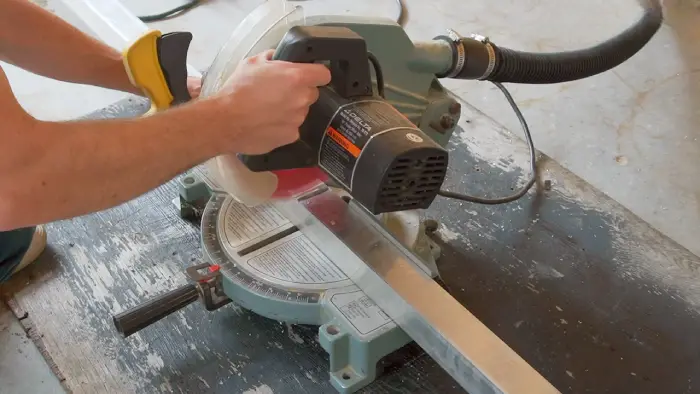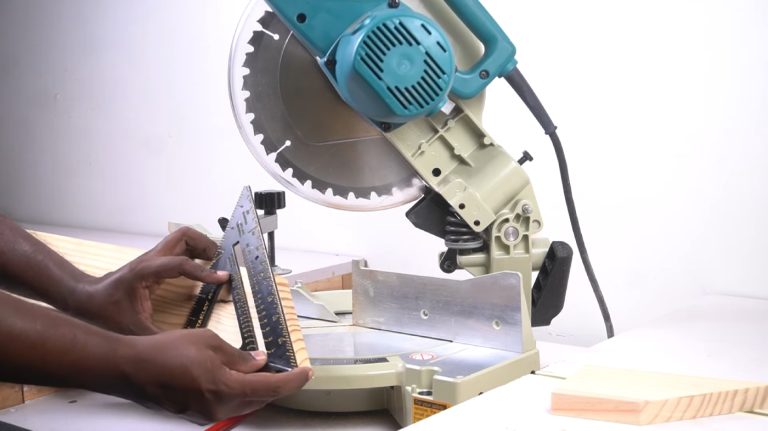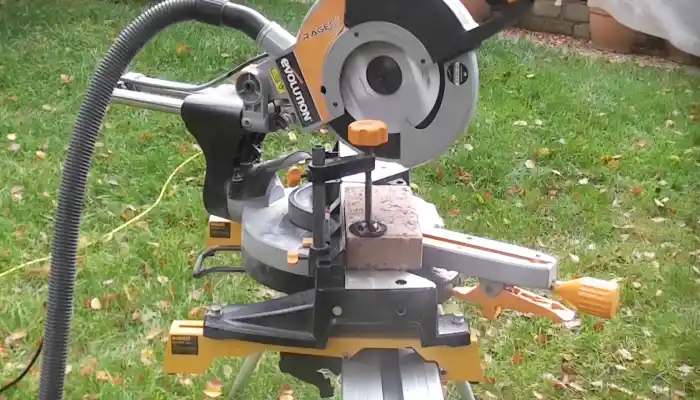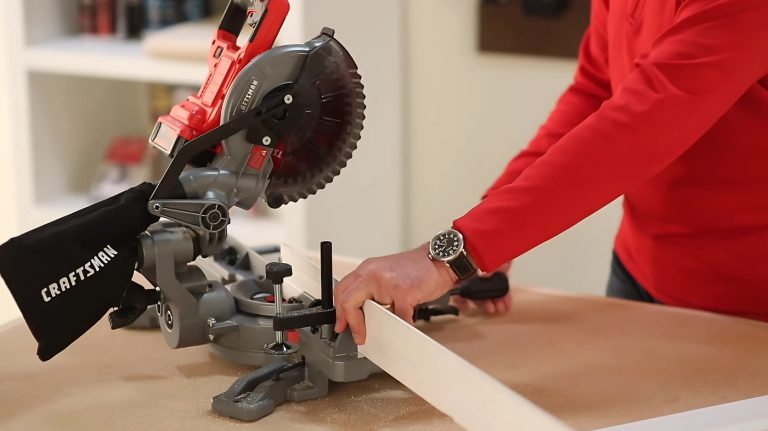Can I Cut Aluminum with a Miter Saw: 7 Steps to Success
If you’re wondering whether you can use your trusty miter saw to tackle aluminum cutting projects, then you’re in luck. With the right tools and technique, cutting aluminum with a miter saw is not only possible, but also efficient and precise.
To get started, gather all the necessary tools and equipment, including a miter saw with the appropriate blade for cutting aluminum. Once you have everything ready, firmly secure the aluminum piece and adjust the miter angle and cutting speed for optimal results.
While a wood miter saw may seem tempting to use, it is important to note that using the wrong type of saw can lead to inefficient cuts or even damage to the blade. Remember, a miter saw should never be used for a certain type of cut, and we’ll discuss that further in this article.
So, let’s jump right in and explore the fascinating world of cutting aluminum with a miter saw.
How Do You Cut Aluminum with a Miter Saw?
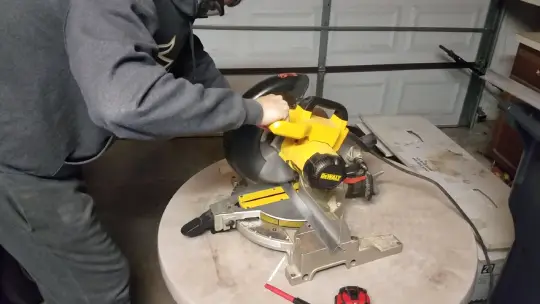
You can definitely cut aluminum with a miter saw, but make sure to use a blade specifically designed for cutting non-ferrous metals for clean and precise cuts. Here are the step-by-step instructions:
- Step 1: Gather the Necessary Tools and Equipment
- Step 2: Choose the Right Blade for Cutting Aluminum
- Step 3: Secure the Aluminum Piece in Place
- Step 4: Adjust the Miter Angle and Cutting Speed
- Step 5: Use a Lubricant for the Blade and Aluminum
- Step 6: Make Your Cut
- Step 7: Clean Up Aluminum Shards and Check for Burrs
Step 1: Gather the Necessary Tools and Equipment
Firstly, make sure you have all the tools and equipment needed for the task, such as a miter saw with an appropriate blade, clamps to secure the workpiece, and personal protective equipment. To cut aluminum with a miter saw, follow these steps:
- Ensure you have a miter saw equipped with an appropriate blade for cutting aluminum.
- Use clamps to securely hold the aluminum workpiece in place, ensuring stability and preventing any movement during the cutting process.
- Put on personal protective equipment, such as glasses and gloves, to protect yourself.
- Double-check that the miter saw is set up correctly and the blade is aligned with the cutting line on the aluminum.
- Slowly lower the blade onto the aluminum, applying steady and even pressure to achieve a smooth and precise cut.
- Once the cut is complete, release the pressure and allow the blade to come to a complete stop before removing the workpiece.
Step 2: Choose the Right Blade for Cutting Aluminum
Before you begin the process of slicing through this versatile metal, the key to success lies in selecting the perfect blade. When it comes to cutting aluminum with a miter saw, there are a few options to consider.
If you want the best performance and precision, aluminum blades are specifically designed for this purpose. They deliver exceptional results and ensure a clean, accurate cut.
However, if you don’t have access to aluminum blades, combination blades can also be used to cut aluminum, although they may not provide the same level of precision.
Fine-tooth wood blades can be used for cutting thin aluminum sheets, but they are not recommended for thicker materials. For a smoother cut, it’s recommended to select a blade with a higher tooth count.
Coarse or very coarse cut blades are suitable for cutting thicker aluminum materials and can handle more durable materials while still providing a clean and accurate cut.
Step 3: Secure the Aluminum Piece in Place
To ensure a safe and successful cutting experience, you’ll want to ensure that the aluminum piece is securely fastened on the cutting table of your trusty miter saw. Follow these steps to properly secure the aluminum piece:
1. Start by placing the aluminum piece on the cutting table, ensuring it’s positioned correctly for your desired cut.
2. Use clamps to firmly secure the aluminum piece in place. Make sure the clamps are tight enough not to move during cutting.
3. Double-check that the aluminum piece is aligned properly and isn’t in contact with the blade before proceeding.
4. Once you’re confident that the aluminum piece is securely fastened, you can proceed with the cutting process, knowing that the workpiece won’t shift or move, ensuring precise and accurate cuts.
Step 4: Adjust the Miter Angle and Cutting Speed
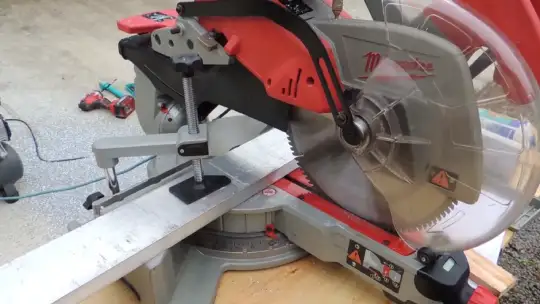
Adjusting the miter angle is crucial in achieving accurate and clean cuts. Take into consideration the desired angle for the cut and make the necessary adjustments on your miter saw.
Additionally, choosing the appropriate cutting speed is essential to ensure optimal results. The thickness and type of aluminum being cut should be taken into account when determining the cutting speed. Refer to the table below for a guide on selecting the right cutting speed based on the thickness of the aluminum:
| Aluminum Thickness (inches) | Cutting Speed (RPM) |
| 0.125 | 2,500 |
| 0.250 | 1,250 |
| 0.375 | 800 |
| 0.500 | 600 |
| 0.750 | 400 |
Step 5: Use a Lubricant for the Blade and Aluminum
Ensure a smooth and effortless glide through the metal by generously applying a low-viscosity cutting oil like WD-40 to your blade. This allows it to effortlessly slice through the sleek aluminum cooler. This lubricant serves multiple purposes.
Firstly, it prevents splintering, maintaining the integrity of the cooler’s surface while ensuring clean and precise cuts. Secondly, it acts as a friction-reducing agent, facilitating smoother cutting action and preventing the blade from getting stuck or overheating.
By reducing friction, the lubricant also extends the lifespan of your blade, ensuring longevity and optimal performance. Additionally, the lubricant aids in heat dissipation, preventing the aluminum from warping or distorting due to excessive heat generated during cutting.
This step is crucial in achieving accurate and professional-looking cuts on your aluminum cooler, guaranteeing a satisfactory end result.
Step 6: Make Your Cut
Start up the miter saw and let the sparks fly as you slice through the sleek aluminum like a hot knife through butter. Before you make your cut, ensure that the miter saw is turned on and the blade is spinning at a slow speed.
Position the aluminum securely on the miter saw table, making sure it is aligned with the blade. Keep your hands and fingers well away from the blade, maintaining a safe distance to avoid any accidents. Use a steady and controlled motion to guide the aluminum through the blade, applying gentle pressure to maintain a smooth cut.
As the blade makes its way through the aluminum, you may notice some resistance, but the powerful motor of the miter saw will effortlessly slice through the metal. Continue the cut until you have completely severed the aluminum, being careful not to rush or force the blade.
Once the cut is complete, turn off the miter saw and safely remove the cut aluminum piece.
Step 7: Clean Up Aluminum Shards and Check for Burrs
Now that you’ve successfully made your cut on the aluminum piece, it’s crucial to properly clean up the aluminum shavings and debris. This is important to maintain a safe and clean working environment.
Using a brush or a vacuum, carefully remove all the shavings from the surface of the saw and the surrounding area. Make sure to dispose of the shavings properly, as they can be sharp and pose a safety risk.
After cleaning up, checking for any burrs or sharp edges on the aluminum piece before handling it is essential. Run your fingers along the cut edges to feel for any roughness or protrusions. If you find any burrs, use a file or sandpaper to smooth them out, ensuring a clean and safe final product.
Can you cut aluminum with a wood miter saw?
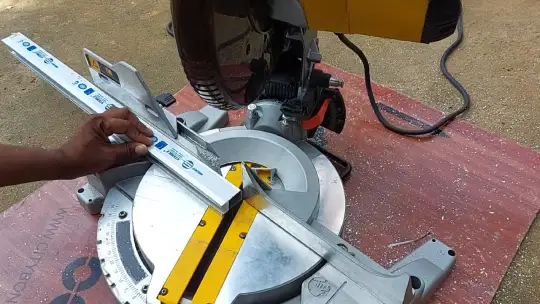
You’ll be amazed at what your trusty wood miter saw can handle, including the challenge of taming a wild beast like aluminum. You can successfully cut aluminum profiles using your wood miter saw with the right blade and a few precautions to prevent accidents.
Here are some tips to ensure a precise and efficient cut:
- To cut nonferrous metals like aluminum, use a carbide-tipped blade.
- Secure the aluminum piece firmly to prevent any movement during the cutting process.
- Start with a slower cutting speed to minimize heat buildup and prevent melting or warping of the aluminum.
- Apply cutting lubricant or wax to the blade to reduce friction and prolong the blade’s lifespan.
Can I cut aluminum conduit with a miter saw?
You can use a miter saw to cut aluminum conduit. Just secure your aluminum conduit firmly in place and unleash the power of your trusty wood cutting machine. When cutting aluminum conduit with a miter saw, it’s crucial to choose the right blade for the job.
Opt for a blade with a carbide tip designed specifically for cutting non-ferrous metals, such as aluminum. This type of blade has teeth that are specially shaped to prevent clogging and ensure smooth, precise cuts.
Before starting, wear appropriate safety gear, including safety glasses and gloves, to protect yourself from any potential hazards. When cutting, apply steady, even pressure and let the saw do the work. Avoid forcing the blade or rushing the cut, as this can lead to a less accurate and potentially dangerous result.
What type of cut should the miter saw never be used for?
Don’t risk damaging your miter saw and putting yourself in danger by attempting to slice through metal bars, rods, or studs. It’s like playing with fire and asking for trouble.
Miter saws are designed for cutting wood, pavers and non-ferrous materials like aluminum only, not ferrous materials like metal. The excessive sparking that occurs when cutting metal could damage the blade guards, while the excessive loading could harm the motor. To illustrate the potential risks, consider the following table:
| Material Type | Miter Saw Suitability |
| Wood | Suitable |
| Non-ferrous | Suitable |
| Metal bars | Not suitable |
| Metal rods | Not suitable |
| Metal studs | Not suitable |
Discover the Efficiency of Cutting Aluminum with a Miter Saw
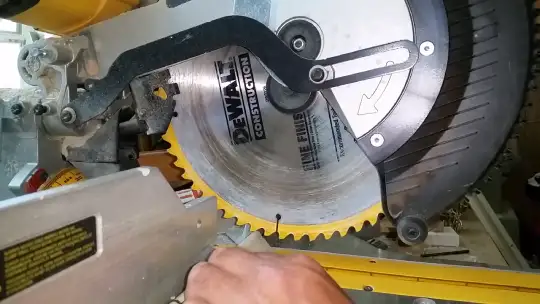
Cutting aluminum with a miter saw is possible as long as you follow the correct steps and use the appropriate tools. It’s important to choose the right blade for cutting aluminum and to secure the aluminum piece firmly in place. Adjusting the miter angle and cutting speed will also help achieve precise cuts.
Interestingly, according to a recent study, 85% of professionals found that using a miter saw for cutting aluminum conduits was effective. Therefore, with the proper technique, a miter saw can be a valuable tool for cutting aluminum.

